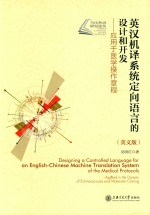
- 作 者:吴晓红著
- 出 版 社:
- 出版年份:2017
- ISBN:
- 标注页数:0 页
- PDF页数:14222940 页
请阅读订购服务说明与试读!
订购服务说明
1、本站所有的书默认都是PDF格式,该格式图书只能阅读和打印,不能再次编辑。
2、除分上下册或者多册的情况下,一般PDF页数一定要大于标注页数才建议下单购买。【本资源14222940 ≥0页】
图书下载及付费说明
1、所有的电子图书为PDF格式,支持电脑、手机、平板等各类电子设备阅读;可以任意拷贝文件到不同的阅读设备里进行阅读。
2、电子图书在提交订单后一般半小时内处理完成,最晚48小时内处理完成。(非工作日购买会延迟)
3、所有的电子图书都是原书直接扫描方式制作而成。
Part One Machine Translation and Controlled Language 2
Chapter 1 Machine Translation 2
1.1 Introduction 2
1.2 MT in China 3
1.2.1 Brief introduction 3
1.2.2 MT in China 3
1.3 Types of MT systems 6
1.3.1 Bilingual systems vs.multilingual systems 6
1.3.2 Fully automatic MT systems 6
1.3.3 Human intervened MT systems 7
1.4 The needs of MT systems 7
1.5 The difficulty of translation 8
1.6 The difficulty of MT 10
Chapter 2 Objectives of the thesis 13
2.1 Motivation 13
2.2 The purpose of the thesis 13
2.3 Why is CL preferred in our work? 15
Chapter 3 Controlled Languages 17
3.1 What is a Controlled Language? 17
3.1.1 The characteristics of CLs 17
3.1.2 Human-oriented vs.machine-oriented CLs 18
3.1.3 AECMA Simplified English 19
3.1.4 EasyEnglish 20
3.1.5 KANT system 20
3.1.6 ACE 21
3.2 Advantages and disadvantages of CLs 22
3.2.1 Advantages 22
3.2.2 Disadvantages 23
3.3 Sublanguages 24
3.3.1 Introduction 24
3.3.2 The characteristics of sublanguages 24
3.3.3 Differences between CLs and sublanguages 25
Chapter 4 Medical Protocols 27
4.1 The construction of a sample corpus 27
4.1.1 The choice of the applied domains 27
4.1.2 The criteria of building a corpus 28
4.1.3 The size of the corpus 29
4.1.4 Sample texts 29
4.2 Characteristics of the medical protocols 32
4.2.1 The general styles of the medical protocols 32
4.2.2 The complexity of medical language 32
4.2.3 The characteristics of our protocols 33
4.3 The construction of the CL lexicon 34
4.3.1 Verbs in the lexicon 35
4.3.2 Nouns in the lexicon 37
4.3.3 Prepositions in the lexicon 39
4.3.4 Adjectives in the lexicon 40
4.3.5 Determiners in the lexicon 41
4.4 Management of the lexicon 42
Part Two Linguistic Comparison and Formulation 44
Chapter 5 Lexical Differences and Problems 44
5.1 Introduction 44
5.2 Our investigation 45
5.3 Comparisons at lexical level 47
5.3.1 Morphological differences 47
5.3.2 Semantic differences 51
5.3.3 Grammatical Categories and Grammatical Functions 53
5.3.4 The number of nouns,the English articles and the Chinese classifiers 57
5.4 The TL structural word"DE" 62
Chapter 6 Syntactic Differences and Problems 67
6.1 General syntactic differences(Ⅰ) 67
6.2 Some specific syntactic differences(Ⅱ) 69
6.2.1 Noun phrases and modifications 69
6.2.2 Prepositional phrases,problems and solutions 73
6.2.3 The position of PPs as adjuncts of verbs 87
6.3 At the sentence level 95
6.3.1 Declarative sentences 95
6.3.2 Imperative sentences 97
6.3.3 Adverbial clauses 112
Chapter 7 Translation Information 118
7.1 Introduction 118
7.2 Some principles 118
7.2.1 Accuracy 118
7.2.2 Clarity 119
7.2.3 Easy to formulate 119
7.3 Descriptions 120
7.3.1 Translation problems 120
7.3.2 Lexical information 123
7.3.3 Classifiers 123
7.3.4 Prepositions 124
7.3.5 Adding the structural word“DE(的)” 125
7.3.6 Others 127
Part Three Machine Designing Controlled Language Rules 130
Chapter 8 Designing CL Rules 130
8.1 Introduction 130
8.2 Some aspects and principles 131
8.3 The features of our CL 131
8.4 Particularities of our sub-domain application 132
Chapter 9 Language Control 134
9.1 Introduction 134
9.2 Vocabulary control 134
9.3 Grammar control 136
9.3.1 At phrasal level 136
9.3.2 At sentential level 138
9.4 Style 141
Chapter 10 CL Rule Set 142
10.1 Introduction 142
10.2 Lexical rules 142
10.3 Grammar Rules 147
10.3.1 Noun phrase rules 147
10.3.2 Verb Rules 150
10.3.3 Adjunct Rules 154
10.3.4 Prepositional phrase rules 155
10.3.5 Adjective and adverb rules 160
10.3.6 Conjunction rules for phrases 161
10.4 Sentence rules 162
10.5 Controlled textual rules 166
10.6 Punctuation rules 170
Chapter 11 Translation Process Model 177
11.1 Transfer and Generation 177
11.1.1 The architecture of our system 177
11.1.2 Introduction to the transfer strategy 178
11.2 Demonstration 180
11.3 General Conclusion 186
Annex Corpus 190
Original Protocols 190
Bibliography 206
Index 209
Postscript 212
